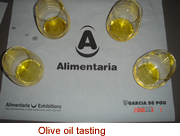 The sixteenth edition of the ‘Alimentaria 2006' concluded last week in Barcelona. One of the biggest food and wine shows on earth, this bi-annual trade show encompasses product segments like food, drinks, meat and dairy products, olive oil, sweets and confectionery and most importantly, wine.
The sixteenth edition of the ‘Alimentaria 2006' concluded last week in Barcelona. One of the biggest food and wine shows on earth, this bi-annual trade show encompasses product segments like food, drinks, meat and dairy products, olive oil, sweets and confectionery and most importantly, wine.
At the first instance it may appear to the first time visitors as an all Spanish show with the 17 autonomous regions vying for the top spot for their diverse products. But a little familiarization helps one understand that this trade show has opted for a model based on arranging exhibitors into dedicated sector-specific shows in order to facilitate and optimise visits by professionals. The International Pavilion and the 1500 foreign companies justify its global status.
The 122,000 square meters of exhibition and activities space had nearly 5,000 food and drinks manufacturers and distributors from 70 countries. A total of 150,000 professionals, including 40,000 from abroad, including me visited the Show celebrating its 30 th anniversary.
A long list of parallel activities makes Alimentaria a 5-day food and wine capital of Spain where there is always something to see and do: various congresses and scientific activities, The International Food Forum, the Congress on the Mediterranean Diet, the innovation show Innoval and the Business Co-operation Projects are a few of the more important initiatives.
In addition, Alimentaria offered visitors various recreational, demonstration and educational events. Spain, the Land of 100 Cheeses, was the complete route through the Spanish cheese map with 100 compulsory stops. Education about wine and its culture, plus wine-tasting, was in the heart of Intervin. There were guided and independent olive oil tastings at Olivaria. Restaurama offered the tired visitors a complimentary sampling of various coffees that included Italian Illy etc., and Indian Tata, courtesy Indian Coffee Board, one of the international participants.
Torres, Freixenet, Codorni`u are the wine labels we identify in India due to their easy availability. Vega Sicilia and Pingus are the international icons that are the envy of discerning connoisseurs. But a visit to Intervin, the area where wines from various rovinces including Canary Islands in the South of Spain and Baleares Islands to the east of Barcelona offer wines which vary from quaffable value-for-money wines to the elegant, full, powerful, seductive wines drinkable from ‘young and now' to those maturing deliciously for 10, 20 years or more.
The grapes that make the permutation possible are the local Tempranillo and Granacha grapes with international varietals used mostly as blends, though many modern producers are experimentally successfully with Cabernet, Pinot Noir and Syrah as the majority players in the symphony.
Rioja, Ribera del Duero in the North are the best known regions  internationally, especially for red wines. Aging of wines in oak barrels is more a rule than the exception and wines are classified by aging. Even the young drinking Crianzas spend two years in bottle and wood. More cherished Reservas must mature for 36 months in cask or bottle, including at least 12 months in oak casks. Gran Reservas are the ultimate in red wines. Living for 24 months in oak and 36 months in the bottle, their tannins get tamed and they become very complex and a connoisseur's delight. These wines are the classic partners of ham, the Spanish all-time favourite, pork and mutton. For the amount spent on oak, these wines are remarkably well-priced and can age for 20 years or better. High barrel and inventory costs make many wineries stick to the affordable Reservas which offer very good quality at very reasonable price.
internationally, especially for red wines. Aging of wines in oak barrels is more a rule than the exception and wines are classified by aging. Even the young drinking Crianzas spend two years in bottle and wood. More cherished Reservas must mature for 36 months in cask or bottle, including at least 12 months in oak casks. Gran Reservas are the ultimate in red wines. Living for 24 months in oak and 36 months in the bottle, their tannins get tamed and they become very complex and a connoisseur's delight. These wines are the classic partners of ham, the Spanish all-time favourite, pork and mutton. For the amount spent on oak, these wines are remarkably well-priced and can age for 20 years or better. High barrel and inventory costs make many wineries stick to the affordable Reservas which offer very good quality at very reasonable price.